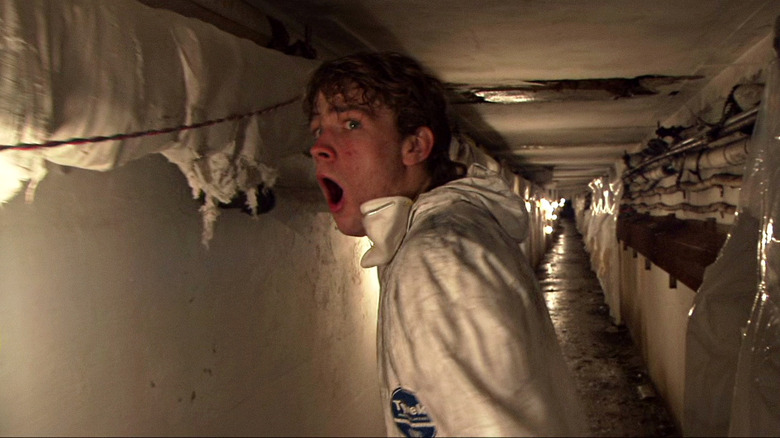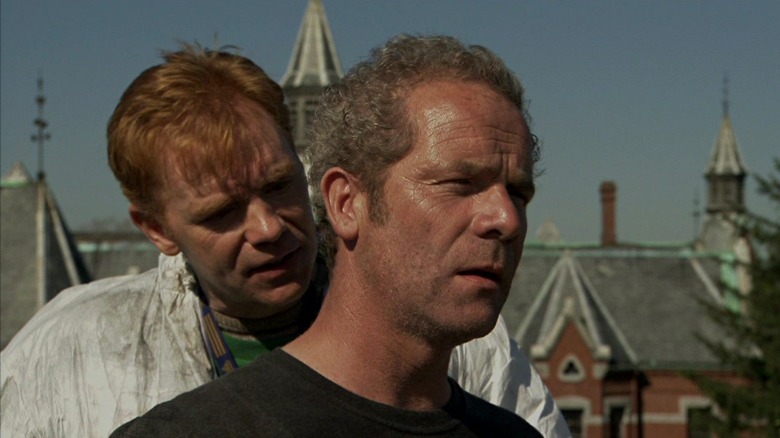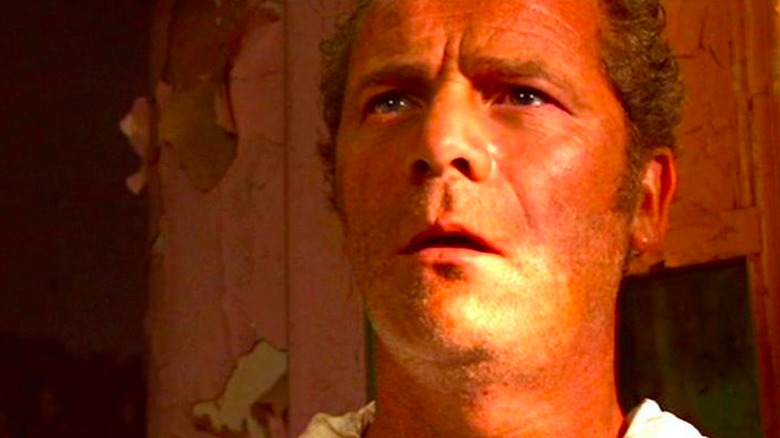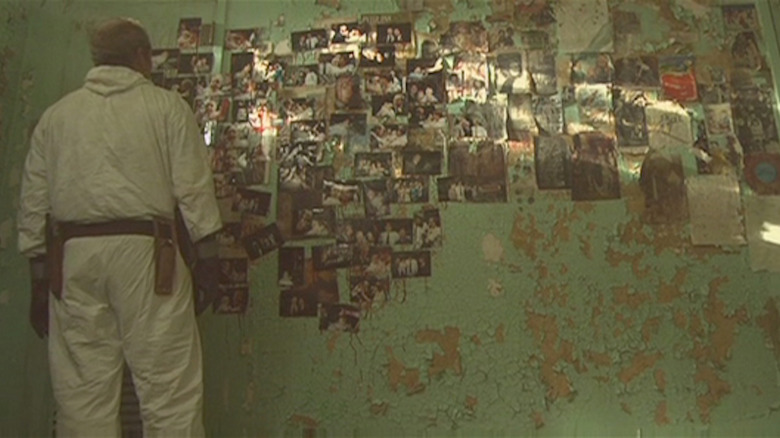Session 9 Ending Explained: Where Is My Mind?
The state of the horror film improved drastically at the turn of the millennium. There were still plenty of uninspired slasher flicks cluttering multiplexes, but an up-and-coming generation of filmmakers who dearly loved the genre were spinning slow-burn tales of supernatural and psychological terror. Kiyoshi Kurosawa, Guillermo del Toro, and Alejandro Amenábar slithered under our skin with moody freakouts like "Pulse," "The Devil's Backbone" and "The Others." These weren't popcorn diversions; these movies lingered in memory long after you staggered out of the theater. And no movie left viewers more rattled — and with more eerily unanswered questions — than Brad Anderson's "Session 9."
It has an unforgettable wallop of a finale. The mental anguish inflicted on the five men toiling within the confines of the creepy, long-shuttered Danvers State Mental Hospital in Massachusetts has boiled over into murder. Peter Mullan's Gordon, the owner of the company hired to strip the asbestos out of the building, has evidently killed every single one of his employees, and, in a gruesomely devastating twist, his wife and daughter. What prompted this seemingly sane man to commit such heinous actions? Was it a demon, a suppressed compulsion, or the asylum itself? Anderson has left open the door to a supernatural explanation for the disturbing goings-on in his film, but it's not until the closing scenes that he commits to one interpretation.
What happens at the end of "Session 9" is clear. What it means is another matter altogether.
What you need to remember about the plot of Session 9
The star of "Session 9" is the very real asylum, a crumbling 700,000-square-foot edifice that once housed so many patients they had to stash some in the narrow subterranean corridors featured in the movie. It is a sprawling palace of pain, and it doesn't take long for its history to wreak havoc on the psyche of the men charged with scraping it free of fibrous toxicity.
Mullan's Gordon is the operator of an asbestos abatement company. He comes on as an apparently steady man who's taken the high-pressure, week-and-out gig to support his wife and newborn child. His employees are his nephew Jeff (Brandon Sexton III), the bitter Phil (David Caruso), degenerate gambler Hank (Josh Lucas), and law-school washout Mike (Stephen Gevedon). There are surface tensions (especially between Phil and Hank), but Gordon strikes us as a capable leader. He'll bring them through.
The asylum, however, has other ideas. Initially, we're primed for a haunted mansion yarn. There's a voice ominously calling out to Gordon, and a collection of nine reel-to-reel recordings of an interview conducted with Mary Hobbes (Jurian Hughes), one of the institution's previous inhabitants, who, suffering from dissociative identity disorder, murdered her parents and little brother. Mike takes an interest in these sessions, and, as his co-workers begin to unravel, we sense that Mary's malignant personality, Simon, might be driving everyone into a violent lather.
Anderson flirts with the supernatural element because Danvers, like the Overlook Hotel of Stanley Kubrick's "The Shining," looks like it was built to be haunted. When Hank disappears (after getting the outer wall of a crematorium buried in the structure's bowels to pay out like a slot machine), and reappears to Jeff as a babbling, zombie-like figure, we're certain there are chaotic spirits at play. Anderson does not dissuade us from this assumption, which makes the film's payoff all the more shocking.
What happened at the end of Session 9
After Jeff is assaulted and Mike goes missing, a distressed Gordon reenters the asylum to find Phil standing over Hank's corpse. Only it's not a corpse. Hank is alive, and he's got a lobotomy spike — which he discovered in the crematorium (thus suggesting many of the institution's previous inhabitants were subjected to this barbaric procedure) — embedded in his eye. He speaks to Gordon in a brain-damaged daze.
Gordon is shocked as the evidently psychotic Phil shouts at him to "wake up." This all goes down as Hank's replacement, Craig (Larry Fessenden), shows up to help the remaining workers to finish the job. Upon his appearance, Phil disappears into thin air (because he was never really there). Before Craig can make sense of the situation, Gordon wrestles him to the ground, Excaliburs the spike out of Hank's frontal lobe, and drives it into the new arrival's socket.
Gordon is the killer. But what possessed him to do this?
Earlier in the film, Gordon confessed to Phil that he'd struck his wife in fury after she accidentally splashed him with boiling water. He's had no contact with her since this incident. As Anderson reveals each of Gordon's victims, we realize he did far worse than this. Over a montage of family photos, an audio track makes it shockingly clear that Gordon's murdered his wife, child, and dog.
In the final moments, we watch a destroyed Gordon begging forgiveness from his wife into a broken cell phone. Anderson then cuts to a helicopter shot of Danvers, over which we hear old tape of the doctor asking Mary/Simon where they live. Their response: "I live among the weak and the wounded."
What the end of Session 9 means
Anderson doesn't give up enough about Gordon's family life, or Gordon himself, to allow us a full understanding of his psychosis, which is both fascinating and frustrating. Thematically, "Session 9" is an open-ended movie (at least for now). Given the esteem in which Gordon's men hold him, my very creaky-limb take here (devoid of deleted-scene analysis, 'cuz if it ain't in the finished film it ain't relevant) is that he's executed them out of pity. He's spared them a lifetime of blue-collar, bill-paying agony because he knows all too well that in every workaday man resides a violent inadequacy.
That's a bleak read, but "Session 9" is a relentlessly bleak movie. These Boston-area guys were raised to believe they were supposed to be more — be kings, even (or their own boss like Gordon) — and they'll only forever be on the precipice of nothing. They were born weak and wounded, and lack the education to do anything about it. The lobotomy is a formality.
What the end of Session 9 could mean for the franchise
The ending of "Session 9" closes the door to Gordon's story (because there's no coming back from killing your family), and leaves open questions about Mary Hobbes's story. Obviously, we know she was beset with a psychological disorder that manifested in the most hideous of ways, but if you're a true crime connoisseur you can't help but wonder what her family was like and whether they knew how dangerous their daughter/sister could be. Anderson and co-writer Gevedon wondered about this, too. In fact, in a 2021 interview with Fangoria, they let slip that they've worked up a prequel covering this very topic.
As Anderson told Fangoria:
"The general gist of the story was that it'd be about Mary Hobbes, the character in the original movie who's on the tapes and who has these alternate personalities and who would ultimately realize she killed her family on Christmas Day. Here we'd learn the entire Mary Hobbes story — how she went from being a fairly normal 12-year-old girl in 1959 and '58 to slaughtering her whole family, and why. Our story was gonna be kind of a portrait of madness through the eyes and the lens of that little girl in the late '50s, early '60s. It's called 'Session 1.' The movie ended with the first session, which would then become a series of sessions that this girl would go through, and ultimately would lead to 'Session 9.'"
Unfortunately, Focus Features, which now controls the rights to "Session 9" and any prospective spinoffs, isn't interested in financing a follow-up to a movie that tanked (due to poor marketing) during its theatrical release. So unless the company has a change of heart, consider "Session 9" distressingly settled business.
"Session 9" is available to rent on all major streaming platforms.




